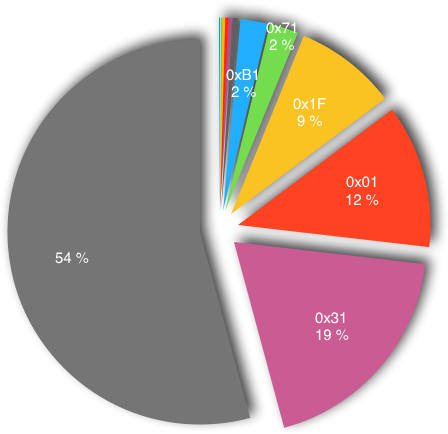ATR statistics: TD2 - Structural, encodes Y3 and T
Article from the series "ATR statistics"
TD2 - Structural, encodes Y3 and T
The ISO 7816-3 specification is not public. So I can't copy/paste part of the text. I will use Wikipedia instead.Refer to TD1 - Structural, encodes Y2 and T since the definition of TD2 is identical to TD1.
| TD2 | # | % |
|---|---|---|
| 1123 | 54.20 % | |
| 0x31 | 393 | 18.97 % |
| 0x01 | 250 | 12.07 % |
| 0x1F | 178 | 8.59 % |
| 0x71 | 50 | 2.41 % |
| 0xB1 | 48 | 2.32 % |
| 0x91 | 10 | 0.48 % |
| 0x21 | 6 | 0.29 % |
| 0x3F | 5 | 0.24 % |
| 0xF1 | 5 | 0.24 % |
| 0x10 | 2 | 0.10 % |
| 0x11 | 2 | 0.10 % |

TD2 (as the other TDi bytes) is structural and indicates:
- How to interpret the other ATR bytes
- What communication protocol the card wants to use
For 54% of the ATRs no TD2 is present. So no other TA3, TB3, TC3 or TD3 is present and no new protocol is defined so the protocol defined by TD1 (if any) will be used.
For 19% of the ATRs TD2 = 0x31. The high nibble is 0011b so TA3, TB3 are present and T=1 protocol is defined. One such ATR is 3B 82 81 31 76 43 C0 02 C5.
For 12% of ATRs TD2 = 0x01. The high nibble is 0000b so no other TA3, TB3, TC3 or TD3 is present and T=1 protocol is defined. One such ATR is 3B 84 80 01 00 00 90 00 95.
0.10% of cards have TD2 = 0x10 and so (re)define the use of T=0. In fact what is important here is the high nibble of TD2 0001b that defines that TA3 is present. One such ATR is 3B DD 96 00 80 10 FE 80 31 80 63 01 FF C0 73 B3 21 1B 81 05.
I will not document all the other cases. I let this exercise to the reader.